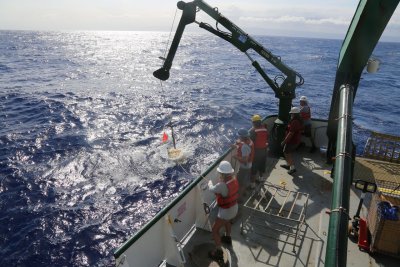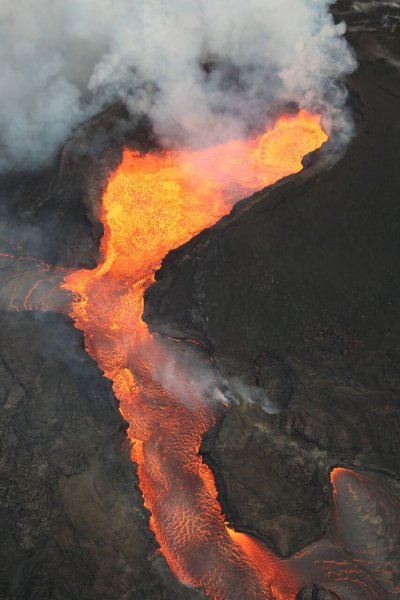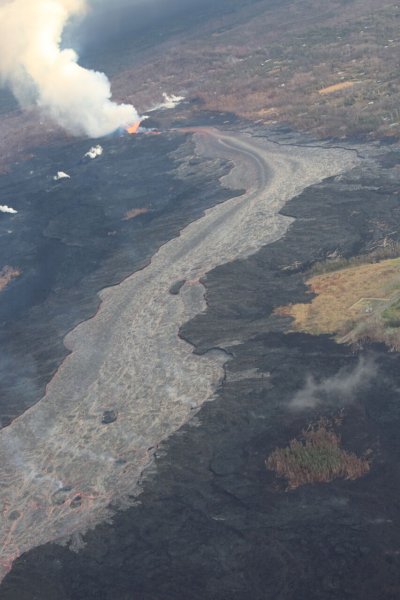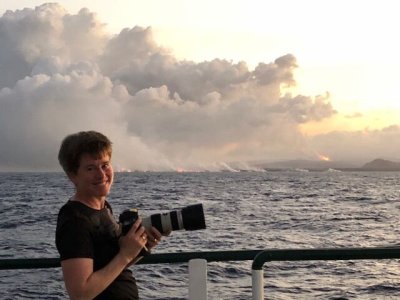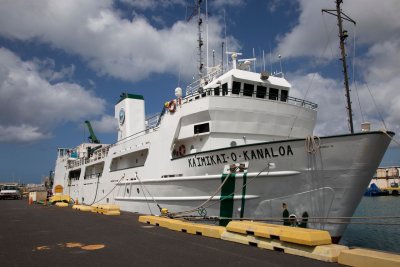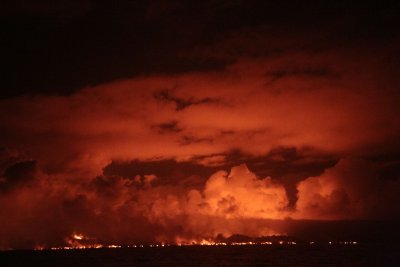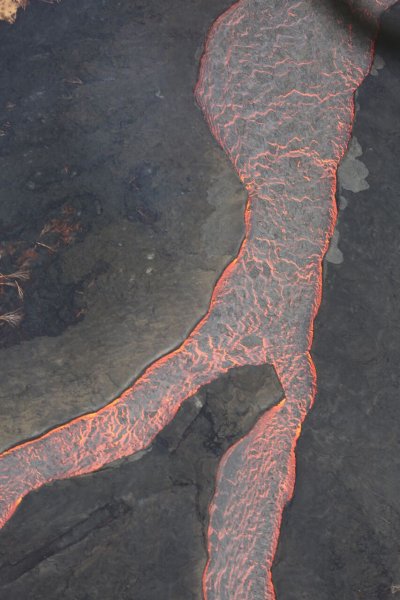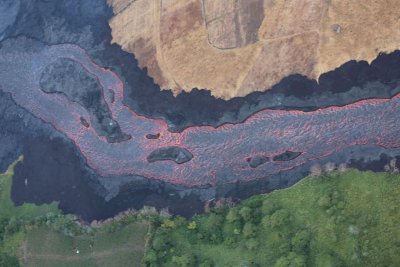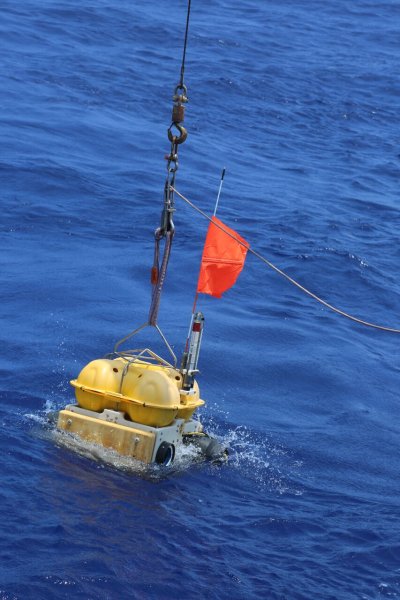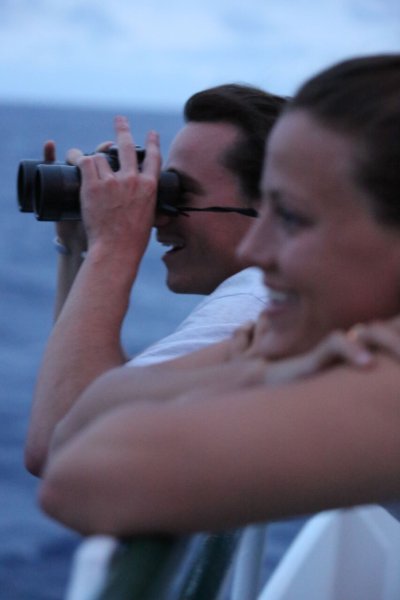Geology's Jackie Caplan-Auerbach Spends Week at Sea Dropping Instruments Offshore of Kilauea Volcano
Requesting funding from research grants via the National Science Foundation (NSF) is usually a painstaking, yearlong process.
But when an extreme event occurs – such as the opening up of huge new vents in the southeastern flank of the Kilauea volcano on the big island of Hawaii, and the subsequent lava flows that have destroyed hundreds of homes in the communities of Leilani Estates and Kapoho south of Hilo – the NSF can bring funds to bear quickly, if scientists can be nimble enough to present a sound proposal.
Western’s Jackie Caplan-Auerbach, an associate professor of Geology and the associate dean of the College of Science and Engineering, just happens to be an expert on undersea volcanism as well as an alumna of the University of Hawaii – so when the eruptions started, she leapt into action.
“It really did come together super quickly,” she said. “But we were able to make it work.”
Together with her colleagues, Julia Morgan of Rice University and Yang Shen of the University of Rhode Island, she applied for special RAPID grant funding from the NSF for a project to drop ocean-bottom seismometers along the southern undersea flank of Kilauea to listen to what the huge, active volcano was doing – especially in the wake of the large magnitude 6.9 earthquake just offshore in the spring.
The proposal was accepted; she just had to find a boat. And some seismometers.
“We got really lucky in both cases,” she said with a laugh.
Caplan-Auerbach was able to wrangle about a dozen seismometers from peers at the Scripps Institute of Oceanography at the University of California at San Diego. A call to colleagues at the University of Hawaii revealed that one its research vessels, the aging but much-loved K’aimikai-O-Kanaloa (“Heavenly Seeker of the Seas” in Hawaiian, but referred to by its passengers simply as the “K-O-K”) was available.
With Geophysics undergrad Lena Gibbs of Lakewood, Colorado and Geology grad student Kevin Lally of Pittsburgh, Pennsylvania in tow, the trio met the rest of the research team in Honolulu, boarded the K-O-K, and headed southwest.
Upon arriving off the south coast of the Big Island, it was quickly apparent that the images on the news every night had, if anything not captured the scope of what was happening, both above and below ground, on the flanks of Kilauea.
“It’s just an incredible scene,” Caplan-Auerbach said. “This new eruptive vent, called Fissure 8, can be seen for miles offshore, and the amount of lava coming from it is enormous, flowing for eight miles before it pours into the sea.”
Kilauea has been erupting continuously since 1983, but she said what is happening now dwarfs anything seen to date – by an order of magnitude.
“The rate of lava pouring out of the ground in this event is far larger than what we’ve seen in the past 35 years. In fact, more lava has erupted in the past three months than what came out in the three previous years combined,” she said.
The researchers and technicians used the week at sea to drop the seismometers at sites as close as 3 kilometers from the island to as far out as 30 kilometers. The instruments will record the sounds and seismic activity along Kilauea’s undersea flank until September, when they will be picked up by another research vessel.
Then it will be time to analyze the data.
This new eruptive vent, called Fissure 8, can be seen for miles offshore, and the amount of lava coming from it is enormous, flowing for eight miles before it pours into the sea.
“What we really hope to find out is to better understand the effect of the eruption on the undersea flank of the volcano. Has the eruption impacted the stability of that part of the island? Probably not, but we need to look at it,” she said. “There have been a series of earthquakes there immediately following the big 6.9 quake, and we are seeing new quakes where historically we haven’t seen many before. Hopefully the data will help us understand what has changed.”
Both Gibbs and Lally said the cruise was an incredible opportunity that they couldn’t pass up.
Lally said the opportunity to study Kilauea’s eruption was too much to pass up.
"Working a week at sea with Jackie and others was a dream come true. It was such an amazing learning experience to be taking action on Hawaii's most recent eruption,” he said.
Gibbs echoed his sentiments.
“This week at sea was one of the most incredible, inspirational and eye-opening experiences for me. Deploying instruments near an erupting volcano off the coast of Hawaii, surrounded by brilliant scientists, it is hard to believe that I was so lucky to be involved. Everyone on the boat had a different story to tell, and yet, we all had ended up on the K-O-K, deploying seismometers off the coast of Hawaii, in order to better understand the world we live in,” she said.
Caplan-Auerbach said it would probably be years before a good understanding really begins to emerge of how this eruption has impacted the island geologically – although there are obvious and immediate signs already.
“For example, Halema`uma`u crater within the Kilauea summit caldera used to be a relatively shallow feature. Since this event began, it has collapsed into a 1,500-foot-deep pit that has been drained of all its lava, and fully half the caldera has subsided by tens of meters. It’s mind-boggling,” she said.
“The caldera is collapsing as lava beneath it flows down the rift zone and erupts at the fissure,’ she said. “It’s an incredible opportunity to see how features like this form.”
Now back from their trip on the K-O-K, Caplan-Auerbach said once she gets the seismometer data back, she will apply for a new grant that would pay for grad students to begin to work up the information recovered from the sea floor.
“It’s a tremendously exciting time, to be able to study a huge, ongoing event such as this,” she said. “But at the same time, this isn’t happening in a vacuum. Thankfully there has been no loss of life, but some of these communities are basically gone, and our hearts go out to those folks. It’s really, really sad.”
